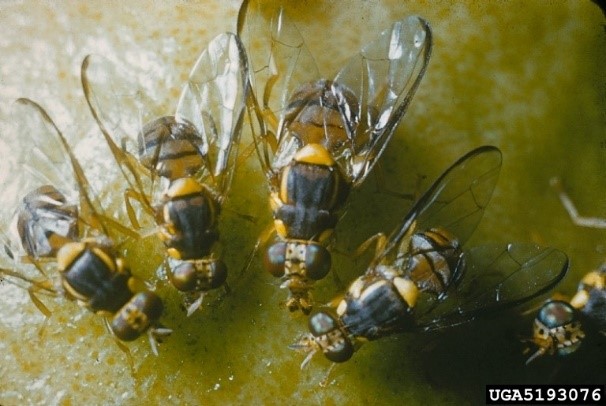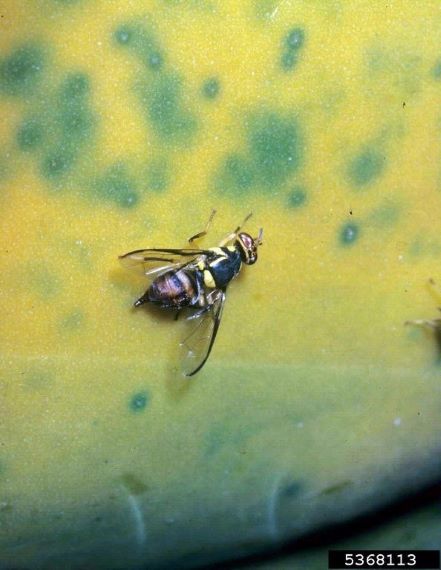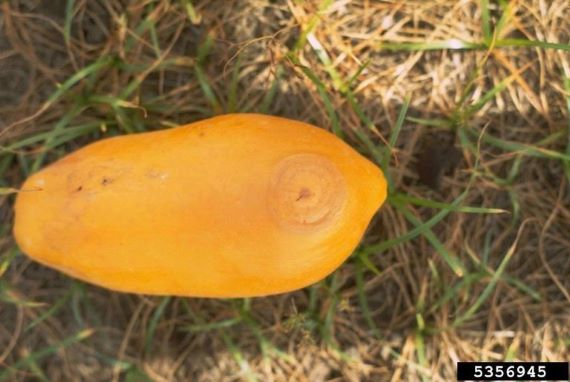
Oriental fruit fly
| Primefact number | Edition | Published | Author |
|---|---|---|---|
| PUB22/111 | First | Mar 2022 | Plant Biosecurity and Product Integrity |



Background
Oriental fruit fly (Bactrocera dorsalis) is one of the most damaging pests of horticulture crops with a reported host range of over 400 types of fruit and vegetables. This insect is a considered a serious threat to Australia’s horticultural industries, with avocadoes, mangoes and papayas as the most common hosts.
Oriental fruit fly has a short life cycle allowing for rapid population increases under favourable conditions. The adult fruit flies lay eggs within mature fruit, resulting in larvae tunnelling through the fruit, causing it to drop to the ground.
A gravid female or a single piece of fruit infected with oriental fruit fly larvae entering the country could lead to economic impacts for individual growers, whole commodities, regions and export markets.
Notifiable Status
Oriental fruit fly (Bactrocera dorsalis) is a notifiable plant pest in NSW.
All notifiable plant pests must be reported within 1 working day. You can report notifiable plant pests and diseases by one of the following methods.
- Call the Exotic Plant Pest Hotline 1800 084 881
- Email: biosecurity@dpi.nsw.gov.au with a clear photo and your contact details
- Report online: online form
A full list of notifiable plant pests and diseases can be found in Schedule 2 of the NSW Biosecurity Act 2015.
Scientific name
Oriental fruit fly (Bactrocera dorsalis) covers 4 fruit fly species including: Bactrocera dorsalis, B. papaya, B. philippinensis and B. invadens. They are all recognised as the same species.
Oriental fruit fly is sometimes referred to as ‘Papaya fruit fly’.
Distribution
Oriental fruit fly is an exotic plant pest and is not currently present on the mainland of Australia, however, it is present on Christmas Island.
It is considered widespread in southern Asia, Hawaii, Africa, and Tahiti.
Oriental fruit fly is known to be established in Papua New Guinea.
Lifecycle
Oriental fruit fly is active between temperatures of 6 - 35 C and prefers warm, tropical climates. In these conditions, the development from egg to adult takes 16 days.
Mature larvae emerge from the fruit and drops to the ground to form a puparium, which occurs in the soil. Ten days after, the adult fly emerges. Sexual maturity occurs another 1-2 weeks later. In optimum conditions, a female oriental fruit fly can lay more than 3000 eggs during her lifetime, but usual production consists of 1200-1500. Flies can continue to live for several months after mating.
In cooler conditions, development periods are extended.
Description
Adults
The adult oriental fruit fly is small, ranging from 6 - 8 mm in length, similar in size to a common housefly.
They have clear wings with a narrow brown band extending along the edge.
The thorax is dark coloured with two yellow stripes on top (Figure 1).
The abdomen is brown to yellow in colour and has two horizontal black stripes with a T-shape extending from the base of the third segment to bottom of the abdomen (Figure 2).
The female has a very slender and sharply pointed ovipositor.
Pupae
The pupae are barrel-shaped and vary in colour from white to yellow-brown. They are 5 - 6 mm in length.
Larvae
The larvae of oriental fruit fly at third-instar are 7.5 - 10 mm in length and 2 mm wide. They typically resemble maggots and are a white creamy colour.
Eggs
The eggs are white to yellowish-white in colour and are approximately 1 mm long and 0.2 mm wide. The eggs are laid within fruit.
Hosts and damage
Oriental fruit fly has a wide host range and has been recorded on more than 400 kinds of fruit and vegetables (USDA 2016). However, avocado (Persea americana), papaya (Carica papaya) and mango (Mangifera indica) are the most common hosts.
Oriental fruit fly damage the fruit by depositing eggs with their ovipositor into the fruit. Damage is identified as necrosis around the puncture mark, followed by decomposition of the fruit and premature fruit drop. Water-spot like markings is also indication of damage (Figure 3). The risk period for damage is within the fruiting stage and post-harvest. Unprotected fruit can result in up to 100% damage.
After hatching, the larvae tunnel and feed internally on the fruit. They can cause considerable damage before obvious signs can be noticed on the outside of the fruit. The larval tunnels also create entry points for bacteria and fungi, contributing to further fruit damage.
Spread
Adult oriental fruit flies spread locally by flight and wind dispersal. With monsoonal winds in the wet season, oriental fruit fly is known to occasionally enter the Torres Strait.
Long distance spread can occur through the transport of fruit infested with larvae and/or eggs. Pupae can also be transported via sand, soil and gravel (e.g. in potted plants).
There is a high likelihood of entry, particularly from accidental or illegal international transport.
Impact
Due to its wide host range, oriental fruit fly is considered one of the most serious and damaging pests in horticulture with the cost of disruption estimated at $2.1 billion annually (ABARES, 2013).
This accounts for 54% of total gross value of all horticultural products produced in a single year.
The last known Australian incursion of oriental fruit fly occurred in 1995 near Cairns, whereby it cost horticultural industries a total of $33 million and four years to eradicate.
Actions to minimise risk
Good on-farm biosecurity practices are important for preventing new pests or diseases entering your farm and spreading to others.
Take steps to prevent the entry, establishment and spread of pests and diseases including:
- Practice “Come clean, go clean”.
- Maintain orchard hygiene by cleaning up fallen fruit.
- Ensure all staff and visitors are instructed in and adhere to your business management hygiene requirements.
- Monitor and control volunteer plants that can harbour pests.
- Source plant material of a known high health status from reputable suppliers.
- Monitor your crop regularly.
- Keep records and refer to your industry biosecurity manual for more information and guidance.

